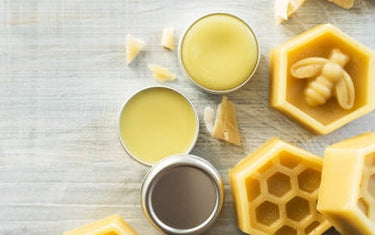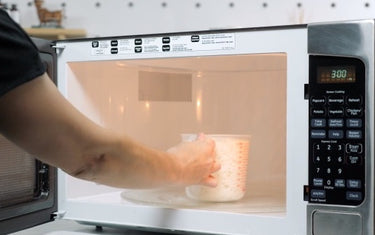5 min read / 18 May 2023 / Laura Garvin Gomez
How to Make a Candle Wick
Candle wicks are, without a doubt, the most important part of the candle making process. Here's how to make your own.
Share this post

Wicks are integral to the smooth burning of your candle, so choosing the right one for you is a big step.
If you're just getting started with candle making, it can feel a little daunting to select a wick from (what feels like) an endless sleuth of technical options.
Inevitably, all a wick does is allow your candle to burn, right? So why is the process so frequently over-complicated? In reality, it's a lot simpler than it seems.
In fact, many first-time and seasoned candle makers like creating their own wicks to save hassle and money. Making a wick for a candle is not only super easy, but also opens up a world of customisations for your range.
If you're interested in how to make a candle wick at home, we're providing all the details you'll need in this handy guide.
Why is making candle wicks correctly so important?
Some candle makers may feel overwhelmed when choosing a wick because of its extreme impact on the overall quality of the candle.
The size, material, and placement of a wick can be the difference between a smooth-running, sleek-looking candle or a mess of tunnels and bubbles. The wick also impacts the quality of the burn, as it's the main source of fuel between the wax and the flame.
Burn quality is most often affected by the size of the wick. If the wick is too thick, it will supply more wax to the flame than is required. This will lead to black soot emerging from your candle. If the wick is too thin, your candle will struggle to light properly at all.
What are candle wicks made of?
There are tons of wick types out there, but the majority will be made out of one of three common materials. These materials are as follows:
1. Cotton wicks
Can you use string as a candle wick? Perhaps unsurprisingly, yes you can. In fact, cotton wicks are the most popular wick variety you'll find on the market.
Cotton wicks are made from fibre bundles and tend to come in two distinct types - knitted/flat braid wicks and square braid wicks.
Flat braided cotton wicks will burn consistently and curl back on themselves. This gives the effect of the wick having self-trimmed. Square braided wicks do not have this effect but are considered more durable due to their bleached cotton material.
2. Wooden wicks
Wooden wicks are becoming increasingly popular in the candle making world due to the satisfying crackling noise they give off when burned.
Despite being relative newcomers, these types of wicks are widely available and come in two varieties: hardwood and softwood.
Because the concept of a wooden wick is so simple, many candle makers find it easier to select wooden wick types for their candles than cotton wick types.
3. Metal cored wicks
Metal cored wicks are less common in candle making nowadays due to the building controversy surrounding their purity and impact on the environment.
Made primarily from metals such as zinc, copper, or tin, metal cored wicks will come in a similar knitted/braided style to cotton wicks, but with a metal centre to help keep them secure.
The main advantage of a metal cored wick is a slightly longer burn time, as these wicks will produce cooler flames and allow the wax to burn slower overall.

How to make a candle wick
Now that you're familiar with the different types of wicks, it's time to start making your own. Cotton wicks and wooden wicks are the easiest to make at home, and tend to be the best choice for your candle too.
Here's a step-by-step guide on how to make both.
Cotton wicks
You will need:
- Cotton strings (feel free to use a selection of different colours)
- Your chosen wax type
- Tongs
- Scissors
- Pliers
- Wick tabs
Method:
- Pick your wick size. The size of your wick will depend on the size of your candle. If you're making a small candle, one cotton string should be sufficient as a wick. If you're making a larger candle, you'll need to braid three strings together and tie a knot at one end.
- Prepare your wicks. If you're using a single wick, cut the string so it's around 3 inches longer than the height of your candle. For braided wicks, cut three equal pieces to around 4 inches longer than your candle height.
- Melt the wax. Melt your wax using your chosen method. If you're not sure which method to use, you can refer to our guide on how to melt candle wax.
- Coat the wicks. Using a pair of tongs, carefully soak the wicks in your wax for about a minute or so. Try to coat as much of the wick in the wax as possible.
- Dry the wicks. Remove your wicks from the wax and hang them to dry. As the wick begins to cool (before it hardens) gently straighten the wick.
- Attach your wick tab. Once your wick has dried, feed the bottom through your wick tab and pinch it into place using a pair of pliers. Your wicks are ready!
Wooden wicks
You will need:
- Balsa wood sticks
- Scissors
- A shallow dish
- Paper towels
- Olive oil
- Wick tabs
- Pliers
Method:
- Using a pair of scissors, cut the wooden sticks to your desired length. This should be one inch taller than the size of your candle jar.
- Fill a shallow dish with olive oil and submerge your sticks in the oil. Leave the sticks to soak for 20 to 25 minutes. This process helps create a clean, even burn for your wicks.
- Take your sticks out of the oil and place them on a paper towel. Leave them to dry for a few minutes. You'll know the sticks are dry when they're damp and oily, but not sticky or overly oily to the touch.
- Once dried, take a wick tab and lightly push one end of the wooden stick into the tab. Use your pliers to secure the stick if needed. Your wicks are ready!
Frequently Asked Questions
What is the best type of candle wick?
Braided and knitted cotton wicks tend to be the best choice for scented candles, particularly if you're making a large candle with multiple wicks. Wood is also a good choice for smaller candles, though.
Can any type of string be used as a candle wick?
No, not all string types will be suitable for use as a candle wick. Cotton strings are generally the safest choice as they have absorbent fibres that can soak up the wax.
What happens if I damage my wick?
If you damage your wick in the process, or if the size isn't quite right for your burn, you can re-melt the wax and use it to make smaller candles, wax melts, or room fresheners.

Choosing the right candle wick for you certainly won't come without its fair share of trial and error, but that's okay!
Part of the candle making process is enjoying the experimentation that comes with it, and making your own wicks means there's an even greater possibility to really make your candles unique.
If you need some additional advice, check out our candle making tips for beginners to help set you on the right path.









